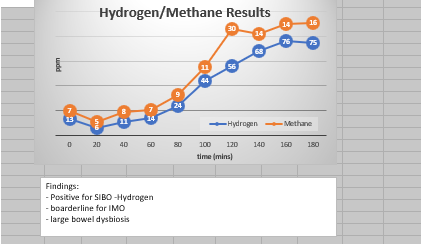Interpreting breath test results
The North American Consensus for interpreting the hydrogen methane breath test results for gastrointestinal disorders give the following guidelines:
- a rise in greater than 20ppm of Hydrogen for glucose or lactulose test within 90 minutes is positive for SIBO (small intestine bacterial overgrowth.
- a rise in greater than 10ppm for glucoses of lactulose test within 90 minutes for methane is positive for IMO (intestinal methanogen overgrowth).
- SIBO needs to be excluded before diagnosis of carbohydrate malabsorption (using fructose or lactose).
Factors to Consider When Interpreting Results
- gut microbiome can be of the class of either hydrogen producers or hydrogen consumers.
- if the gut has more hydrogen consumers present, then the hydrogen being produced will be utilised by the hydrogen consumers such as methanogenic organisms (methane producing organisms) or through the pathway of sulfate reduction (the resulting Hydrogen Sulfide is not being tested at present). Thus there is a delayed rise in hydrogen.
This delayed rise in hydrogen is due to the lactulose initially being consumed by hydrogen producers by fermentation but the hydrogen produced will be uptaken by hydrogen consumers until the hydrogen consumers are completely saturated.
This can result in a flatline for hydrogen results, followed by delayed peak or even a double peak in the results.
Thus it is crucial to consider both methane and hydrogen levels as a low hydrogen initially can result in a false negative result for hydrogen- SIBO.
If you have tested positive for SIBO, the aim of treatment is to:
a) reduce or eliminate bacterial overgrowth.
This may also be achieved through use of antibiotics but this may only kill upto 91% of the overgrowth. Pharmaceutical antibiotics and/or herbal antibiotics can be used.
Reduction or elimination of the bacterial overgrowth can be done by removing fermentable carbohydrate in their diet. Bacteria feeds on starches and carbohydrates that it can ferment so by removing these sources, the overgrown bacteria is starved to death.
A combination of antibiotic and diet restriction is generally used in this phase.
b) repair the damaged lining of the gut
that is focus on improving the integrity of the gut.
and also to improve secretion of digestive enzymes.
This is done through use of appropriate nutrition supplementations and targeted probiotics (a specialised clinical dietitian - nutritionist, naturopath will be able to advise on the right strategy for you).
Maximised Nutrition has no affiliation with any particular products on market for financial gains and so seeks to present clients with the best and appropriate cost effective alternatives.
c) restore gut health and microbiota balance.
In literature, it has been noted that there is relapse of SIBO in clients. As such, it is crucial that steps are taken to restore gut integrity and health and to maintain the right microbiota balance in the gut to prevent future bacterial overgrowth. The use of fermentable food products, natural fibres through fruit and vegetables, and appropriate diet is a key to preventing relapse of SIBO symptoms.
